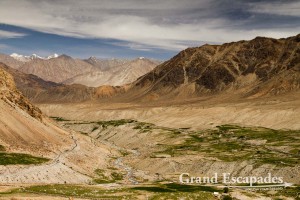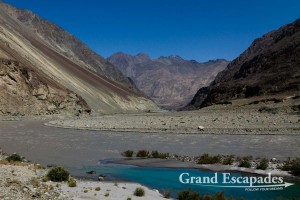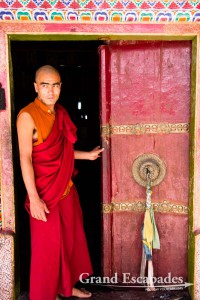
Ladakh is a high altitude desert, with once in a while small ribbons of green run down a slope, nourished by small stream running – Here Gangla Village, on the way from Leh to Khardung La, Ladakh, India
Descending from Khardung La (5.602 meters) towards Nubra Valley, we passed through Ladakh’s second highest village, Khardung, at 4.400 meters! Its lush green beauty brings every traveller to a halt. Given the spectacular scenery we allowed numerous photo-stops and hence five hours for travelling the 115 kilometers between Leh to Khalsar.
This small town is the entry point into the Nubra Valley, one of the most popular excursions from Leh. We had read raving reports about Nubra Valley in various forums and nothing could have stopped us from going there.
Well, the so famous Nubra Valley itself is nothing spectacular! What makes the trip worth every penny is the drive up and down to Khardung La and once in the Nubra Valley, the last 30 kilometers towards the small village of Turtuk, at the very end of the Shyok Valley. Turtuk, in 2013, is how far you could go with your permit – eight kilometers further down is the Pakistani border.
So let’s quickly describe how we experienced arriving in the Nubra Valley: a very wide valley with a river seeping rather than flowing through it, lots of boulders and patches of green make up the valley floor. The small town of Khalsar is a non-descript cluster of semi-finished houses, where we stopped for fried noodles in one of the eateries along the road. The village of Sumur, a short drive from Khalsar, is where many of the two-day visitors stay overnight before driving back to Leh.
Maybe it was the time of our arrival that makes fond memories impossible: at around 02:00 pm we ended up in front of the monastery in Sumur. It was cooking! Visiting seemed an impossible undertaking, but then we spotted a monk taking a group of Ladakhi pilgrims around and we just tagged along. Now this encounter made it a lot more interesting: the monk opened no less than 10 rooms for the pilgrims, who devotedly prayed and made donations in each one of them.
Equally unimpressive is the village of Hundar, west of Khalsar on the road to Turtuk. It is not even a village, rather a cluster of buildings, with quite a few campsites thrown in. The big white tents are popular with Indian tourists. We could not picture ourselves inside, not in this heat. In all of these places, the signs of tourism are omnipresent, considering this is rural, rural India, Don’t expect excellent hotels though, actually we had to check out quite a few – some guesthouses were still under construction, but the owners would rent the rooms anyway – until we decided on the lovely Snow Leopard Guesthouse with its gorgeous garden.



No comments yet.